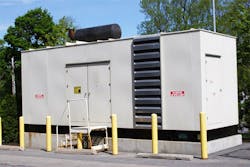Is it an Emergency System or Just an Optional Standby System?
Many unit substations and instrumentation rooms in industrial process facilities use a combination of an uninterruptable power supply (UPS) and generator(s) to bring the process unit down in a controlled manner upon power interruptions.
Depending on the process unit, it can take from 15 minutes to several hours to bring the unit down without incident. Critical instrumentation that must remain functional to safely shut down a unit is typically powered by a UPS. In most arrangements, the UPS batteries are backed up by a generator that supplies voltage to the UPS as well as critical lighting for egress and other critical loads.
So, the question becomes which National Electrical Code (NEC) Article applies to these UPS and generator systems? Are they emergency systems, as defined in Art. 700, or do Articles 701 or 702 apply instead?
The key to figuring out when Art. 700 requirements apply is found in the definition of an “emergency system.” If the backup power systems are legally required — and it’s essential for safety to human life — then Art. 700 applies to these systems. As with many things in the NEC, the authority having jurisdiction (AHJ) will be the one who can legally require the backup power system to be installed. Industrial plants may have many AHJs depending on their location. Anyone from the federal government to the state inspector down to the plant owners may be the ruling AHJ. Article 700 has the most stringent requirements among the three Articles (700, 701 and 702).
Legally required standby systems (LRSSs) [Art. 701] are those backup power systems that may be legally required by the AHJ, but do not involve life safety. Industrial plants rarely have LRSSs in process units.
Most process unit backup systems will either be emergency systems or optional standby systems (Art. 702). Optional standby systems are those backup systems that aren’t legally required nor involve life safety. For instance, if a plant goes down on normal power failure — and the only hazards that could occur is damage to the product or economic damage to the owner — then the owner may opt to comply with Art. 702 in lieu of Art. 700 or 701. Out of the three backup power options discussed above, optional standby systems have the least stringent requirements, and are the most common in industrial facilities.
© 2017 Fluor Corporation. All Rights Reserved.
About the Author
Eddie Guidry
Senior Fellow
Eddie Guidry is a senior fellow with Fluor Enterprises, Inc., Sugar Land, Texas. He is highly skilled in electrical and control systems for industrial construction, design, and engineering (both domestic and abroad). The majority of Eddie’s 38 years of experience includes upstream and downstream portions of petrochemical plants and refineries. He is also heavily experienced in water and wastewater treatment facilities. Eddie is very active in the development of U.S. national (ANSI) and international codes and standards, and has been a principal member of the National Fire Protection Association (NFPA) National Electrical Code (NEC) committee since 1999 and NFPA’s National Advisory Committee on Electrical Safety Research since 2008. Eddie, who has also developed and conducted many electrical courses and seminars over the years, currently holds the corporate Master Electrician license for Fluor Corporation in the State of Texas and is also an ICC/IAEI certified electrical inspector.
